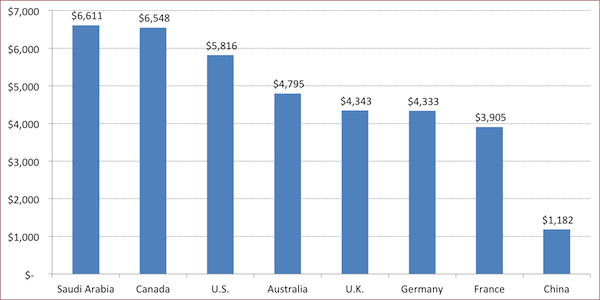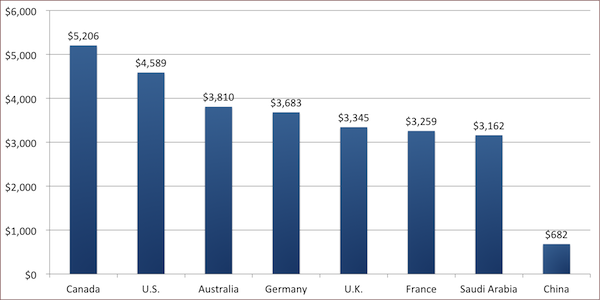– Updated: 8:50 a.m.
Anybody want to keep going on this comparison business? It gets tougher as you move further away from Canada and the North American systems of Academic rank, but why not?
Let’s start with the U.K. Data on salaries is published annually in the Times Higher Education Supplement, which divides the data into two categories: “professors” and “not professors.” The first term is basically analogous to our “full professors” (though we bestow that rank on a third of our academic staff, compared to about 12% in the UK), while the latter is a combination of terms like lecturer, reader, etc., which are similar to our “associate” and “assistant” professorships, but also include some other non-tenure-track ranks as well. That means the latter figures may be a bit on the low side for the UK.
Enough caveats: here’s the comparison for 2009-2010, with 1 GBP = $1.68 CAD.
Academic Salaries, Canada vs. U.K., 2009-10
That’s a 10% gap at the full professor level, and a 40% gap among other academic ranks. We need to adjust that picture a bit: “professor” in the U.K. is the top 12% of staff, and in Canada the top 36% – if we did apples to apples, the gap would certainly be bigger, and as noted above, there’s some reason to believe that the gap actually might not be as large at the non-professor level. Overall, the gap is likely to be in the range of 20-30%.
What about other countries? Well, in 2008 higher ed uber-guru Phil Altbach and his Boston College colleagues published an excellent survey of academic salaries around the world, and they came up with the following:
Average Academic Salaries, 2005-06, in WB $PPP
Saudi Arabia tops the list primarily because of the extraordinary salaries paid to their very top faculty – frequently foreigners – who require a bit of a top-up to remain in the Kingdom. If you look at entry-level faculty, the story changes a bit.
Salaries for Entry-Level faculty, 2005-06 in $WB PPP
What distinguishes Canada from other countries is the very high level of its base rate of academic pay. I’d argue this is pretty clearly an effect of high levels of unionization in Canada: our universities simply don’t pay heavily for progression through the ranks the way the U.S., U.K., China and Saudi Arabia do. The premium for reaching the top rung is a lot higher elsewhere, which is why you still hear university presidents complaining about the difficulty of attracting top talent despite such high average wages.
Maybe flat salary scales are the right policy choice for Canada, I don’t know. It would be interesting to have an open debate about it, though.




 Tweet this post
Tweet this post

Are the last two graphs supposed to be identical?
Um…no. Oops. We’ll fix that.
When I read the Rumbley, Pacheco and Altback paper it seemed pretty clear that the authors did not have a lot of confidence in their findings. The authors take great pains to say that their work is exploratory and that there are many serious limitations and caveats on their conclusions. In addition to those set out by the authors, there are serious problems with the use of simple (rather than weighted) averages, use of preliminary data for Canadian faculty salaries that had just slightly more than half of the Canadian institutions reporting, and problems with adjustments for the nine month academic year used in the United States. I suggest that their results should not be cited without the many caveats and cautions that they include in their paper.
Fair enough. Though the results do line up reasonably well with data on Canada and the US I presented yesterday (and indeed for the UK today).